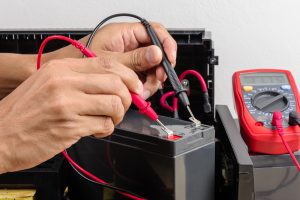In part 6 we look at how to ensure your UPS batteries don’t fail!
Causes of overheating
The high temperatures of batteries can be caused both by the environment's temperature and the heat generated by the batteries themselves. When discharging, batteries absorb heat. In contrast, when charging, they release heat.
When setting up, it is important to keep a minimum 10mm gap between battery blocks when they are installed in racks to avoid overheating and thermal runaway - a condition in which oxygen/hydrogen gas is produced or a battery swells. These batteries have become serious health and safety hazards and cannot be recovered. Here at Computer Power Protection we can help with disposal if this has already happened.
When an individual battery cell deteriorates, it will charge at a quicker rate than the others. It will overheat as it overcharges in an attempt to reach the correct charge level of the other cells in its group. This will create hot spots, and if the cell fails entirely, the rest of the pack, now one cell short, will once again overcharge, creating further heat and shortening the life of the pack. We recommend battery impedance testing to avoid this.
Discharge cycles
The number of discharge-recharge cycles has a major effect on reducing battery life. The amount of energy a battery delivers during a discharge has a significant impact on its longevity. Battery contact deterioration is the primary cause of this.
A battery reaching its end of life prematurely can be caused by constant discharging. Swells and sags in UPS activity should be compensated for in order to avoid battery discharge cycles.
Different battery alternatives
Open vented and valve regulated lead-acid batteries are the two kinds of lead-acid batteries. Valve regulated lead-acid batteries (which vent in case of a problem) are now ubiquitous in place of the older open vented kind. Other kinds of batteries include: Nickel-Cadmium (Ni-Cad) batteries. These are able to work in a wider range of temperatures, -20°C to +40°C, and are more durable. However, cadmium is a hazardous element and the cadmium must be disposed of properly, so the initial purchase price and disposal costs are high. •Gel (sealed) batteries. These aren't as economical as VRLA batteries, therefore they are intended to operate at very low temperatures, and their average life expectancy (especially at around 20°C) is around four to five years.
Shop UPS by Clicking a Popular Brand
Battery configuration – series and parallel strings
Because individual batteries only deliver a relatively small amount of electricity, usually 12V, they are grouped to deliver the required amount of power. A single battery is referred to as a block. This block will be made up of a number of cells. When the blocks are connected together, they form a battery string.
A single string of battery blocks can be connected in series end to end. The overall voltage achieved is the total of all the individual blocks added together. This should match the DC voltage required by the UPS.
The capacity of the string remains the same as each individual battery block. If for example twenty 12V, 10Ah battery blocks are connected together in series this way; the result would be 240V with a 10Ah capacity.
A parallel battery string is a number of series strings wired in parallel. Each of the series strings must contain the same quantity of blocks. The primary reason for this configuration is to increase the Ah rating, the runtime of the UPS. Therefore, if using the previous example of the series string delivering 240V with 10Ah, if three such strings are then wired in parallel, the result would be a power supply of 240V with 30Ah.
Major benefits of parallel battery strings are improved system resilience and protection against the risk of a single faulty battery being responsible for the failure of your standby power system.
Are your batteries needing replacement or a look-over? Get in touch, that's what we are here for.














